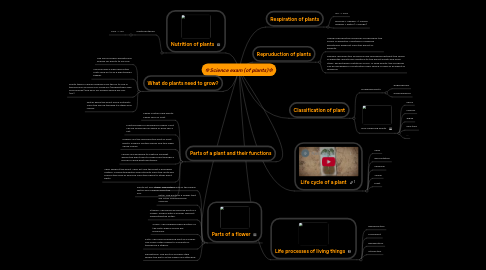❇Science exam (of plants)❇
by Sergi Colobrans


1. What do plants need to grow?
1.1. The sun provides warmth and energy for plants to survive.
1.2. Soil provides a base which the roots hold on to as a plant grows bigger.
1.3. Plants take in carbon dioxide from the air to use in the process of PHOTOSYNTHESIS (making their own food energy) and give off oxygen which we use. (Air)
1.4. Water helps the plant move nutrients from the soil up through its stems and leaves.
2. Parts of a plant and their functions
2.1. Seeds contain new plants. Seeds form in fruit.
2.2. Fruit provides a covering for seeds. Fruit can be fleshy like an apple or hard like a nut.
2.3. Flowers are the reproductive part of most plants. Flowers contain pollen and tiny eggs called ovules.
2.4. Leaves are designed to capture sunlight which the plant uses to make food through a process called photosynthesis.
2.5. They support the plant. They act like the plant's plumbing system, conducting water and nutrients from the roots and food in the form of glucose from the leaves to other plant parts.
2.6. Roots act like straws absorbing water and minerals from the soil.
3. Parts of a flower
3.1. Sepal: The outer parts of the flower
3.2. Petal: The parts of a flower that are often conspicuously colored.
3.3. Stamen: The pollen producing part of a flower, usually with a slender filament supporting the anthe.
3.4. Ovary: The enlarged basal portion of the pistil where ovules are produced.
3.5. Pistil: The ovule producing part of a flower. The ovary often supports a long style, topped by a stigma.
3.6. Receptacle: The part of a flower stalk where the parts of the flower are attached.
4. Nutrition of plants
4.1. Photosynthesis
4.1.1. CO2 -> O2
5. Classification of plant
5.1. Flowering plants
5.1.1. Angiosperms
5.1.2. Gymnosperms
5.2. Non-flowering plants
5.2.1. Ferns
5.2.2. Mosses
5.2.3. Algae
5.2.4. Pine tree
5.2.5. ...
